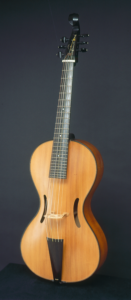Schubert, Arpeggione Sonata
 What is an arpeggione, you ask? Pictured here, it seems to be a cross between a guitar and a cello. Hence its other name: “guitar violoncello.” It has six strings tuned like a guitar (in fourths rather than fifths). So it was well-suited to playing arpeggios, just as a guitar is well-suited to playing chords.
What is an arpeggione, you ask? Pictured here, it seems to be a cross between a guitar and a cello. Hence its other name: “guitar violoncello.” It has six strings tuned like a guitar (in fourths rather than fifths). So it was well-suited to playing arpeggios, just as a guitar is well-suited to playing chords.
But the instrument had a very short period of popularity after its invention in 1823. The repertoire for the instrument includes a single piece by a top-tier composer: this sonata by Franz Schubert (1797-1828).
While most people care very little about the arpeggione, people still care very much about Schubert’s sonata. The work was not published, however, until 1871—long after the instrument had faded from the scene. Today the work is performed on either viola or cello, although many transcriptions have been made for other instruments.
It’s hard not to repeat that Schubert was a great melodist. After repeating that statement, I’m tempted to repeat an explanation of how Schubert’s harmonies make those melodies work. The melodies themselves often seem deceptively simple. That tends to be an asset for a melody. And Schubert presents his melodies with rich chromatic harmonies that also seem to flow effortlessly. But you really can’t listen to this sonata without taking note of those things.
The Heifetz International Music Institute is a summer program for young musicians at Mary Baldwin University in Staunton, Virginia. You might want to learn a little more about it.



